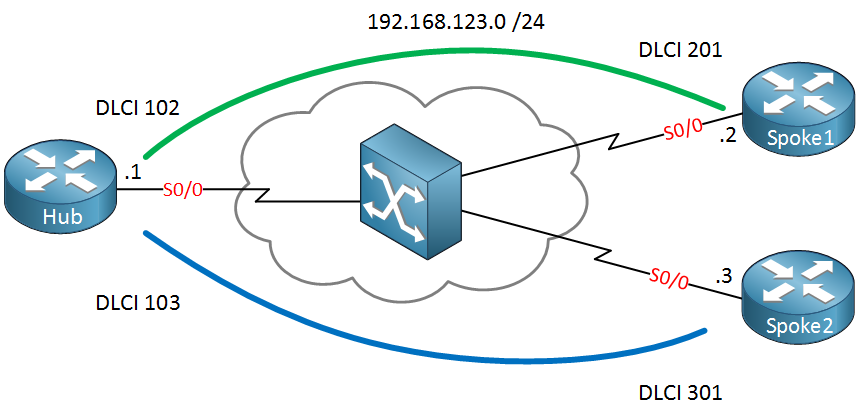In a previous lesson, I showed you how to configure the OSPF point-to-multipoint network type. This time we’ll look at the OSPF point-to-multipoint non-broadcast network type. It’s the same thing, but we’ll have to specify OSPF neighbors ourselves. Here is the topology that we’ll use:

There are a couple of things that you need to be aware of:
- No Automatic neighbor discovery, so you need to configure OSPF neighbors yourself!
- No DR/BDR election since OSPF sees the network as a collection of point-to-point links.
- Only a single IP subnet is used in the topology above.
Here’s the configuration for the Hub router:
Hub(config)#interface serial 0/0
Hub(config-if)#ip address 192.168.123.1 255.255.255.0
Hub(config-if)#encapsulation frame-relay
Hub(config-if)#ip ospf network point-to-multipoint non-broadcast
Hub(config-if)#exit
Hub(config)#router ospf 1
Hub(config-router)#network 192.168.123.0 0.0.0.255 area 0
Hub(config-router)#neighbor 192.168.123.2
Hub(config-router)#neighbor 192.168.123.3This is the hub configuration. I changed the network type to point-to-multipoint non-broadcast, advertised the 192.168.123.0 /24 network in OSPF, and, most important…specified the OSPF neighbors myself. Let’s look at the spoke router configuration:
Spoke1(config)#interface serial 0/0
Spoke1(config-if)#ip address 192.168.123.2 255.255.255.0
Spoke1(config-if)#encapsulation frame-relay
Spoke1(config-if)#ip ospf network point-to-multipoint non-broadcast
Spoke1(config-if)#exit
Spoke1(config)#router ospf 1
Spoke1(config-router)#network 192.168.123.0 0.0.0.255 area 0Spoke2(config)#interface serial 0/0
Spoke2(config-if)#ip address 192.168.123.3 255.255.255.0
Spoke2(config-if)#encapsulation frame-relay
Spoke2(config-if)#ip ospf network point-to-multipoint non-broadcast
Spoke2(config-if)#exit
Spoke2(config)#router ospf 1
Spoke2(config-router)#network 192.168.123.0 0.0.0.255 area 0Just a basic configuration. You’ll have to change the OSPF network type and type in the correct network statements to become OSPF neighbors. Let’s verify the configuration:
Hub#show ip ospf neighbor
Neighbor ID Pri State Dead Time Address Interface
192.168.123.3 0 FULL/ - 00:01:35 192.168.123.3 Serial0/0
192.168.123.2 0 FULL/ - 00:01:56 192.168.123.2 Serial0/0As you can see above, the Hub router has two neighbors. There is no DR/BDR election. That’s all there is to it!
- Configurations
- Hub
- Spoke1
- Spoke2
Unit 1: Introduction to OSPF
- Introduction to OSPF
- Basic OSPF Configuration
- OSPF Multi Area Configuration
- OSPF Reference Bandwidth
- OSPF Plain Text Authentication
- OSPF MD5 Authentication
- OSPF SHA-HMAC Authentication
- OSPF TTL Security Check
- OSPF Default Route
Unit 2: OSPF Neighbor Adjacency
- OSPF LSA Types
- OSPF LSAs and LSDB Flooding
- OSPF Hello and Dead Interval
- OSPF Router ID
- OSPF Packets and Neighbor Discovery
- OSPF DR/BDR Election
- OSPF Passive Interface
- Troubleshooting OSPF Neighbor Adjacency
Unit 3: OSPF Network Types
- OSPF Non-Broadcast Network Type
- OSPF Broadcast Network Type
- OSPF Point-to-Multipoint Network Type
- OSPF Point-to-Multipoint Non-Broadcast Network Type
- OSPF Point-to-Point Network Type
- OSPF Next Hop with Network Types
Unit 4: OSPF Stub Areas
- Introduction to OSPF Stub Areas
- How to configure OSPF Stub Area
- How to configure OSPF Totally Stub
- How to configure OSPF NSSA (Not So Stubby) Area
- How to configure OSPF Totally NSSA (Not So Stubby) Area
- OSPF NSSA P-bit explained
Unit 5: Advanced OSPF Topics
- OSPF Summarization
- OSPF Distribute-List Filtering
- OSPF LSA Type 3 Filtering
- OSPF LSA Type 5 Filtering
- OSPF Virtual Link
- OSPF Virtual Link Authentication
- OSPF Path Selection Explained
- How to read the OSPF Database
- OSPFv3 for IPv4
- Troubleshooting OSPF Route Advertisement
- OSPF SPF Scheduling and Throttling
- OSPF LSA Throttling
- OSPF Incremental SPF
- OSPF Prefix Suppression
- OSPF Stub Router
- OSPF Graceful Shutdown
- OSPF Graceful Restart
- OSPF Loop-Free Alternate (LFA) Fast Reroute (FRR)
- OSPF Remote Loop-Free Alternate (LFA) Fast Reroute (FRR)